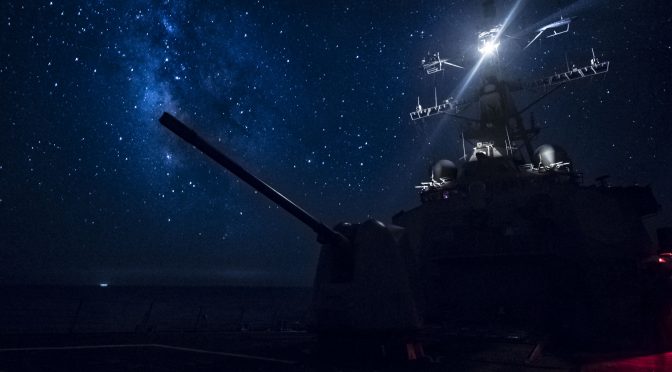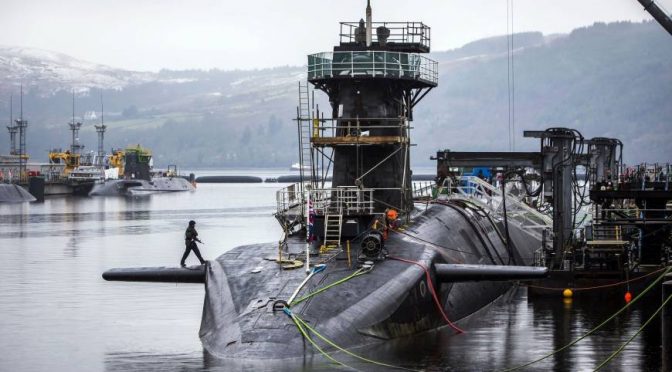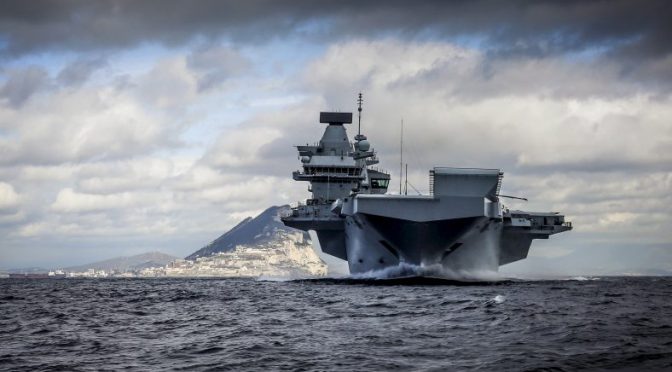Sea Control Topic Week
By Lars Wedin
The sea is growing ever more important. Conflicting interests make it a prime domain for future wars. Historically, securing command of the sea and exercising sea control has been an overall naval strategic objective and a prerequisite for the carrying out of other naval missions. Since the end of the Cold War, the West has been able to exercise Sea Control when so needed without having to fight for command of the sea.1 This comfortable situation is now going away – and it has already disappeared regarding a potential conflict with China.
The Notion of Sea Control
In general terms, sea control means being able to use the sea for one’s own interests while denying an adversary the same possibilities. The French Admiral Castex elegantly summed up what this means: “Depending on having control of the sea or not, one can or cannot
- In an offensive mode, intercept maritime communications of the adversary and attack his territory from the sea,
- In a defensive mode, assure his own communications and stop the enemy from attacking his country from the sea.”2
Castex also insists on the fact that “command of the sea is not absolute. It is simply relative, incomplete, and imperfect.”3
Already during World War II, a prerequisite for sea control was control of the air domain. Today it is more complicated. Land based aircraft and missiles – like the Chinese DF-21D, “carrier killer” missile – affect operations far from the coast. At the same time, naval missiles can strike far inland as showed by Russia when, on October 5-6, 2015, a land-attack cruise missile, Type 3M-14 Kalibr (NATO: Sizzler), was launched from corvettes in the Caspian Sea against targets in Syria.4 Hence, the coastal zone must also be under some control. Modern naval tactics are also heavily dependent on space, cyber, and electromagnetic domains.
To conclude, sea control still means being able to use the sea for one’s own interests but the concept as become much wider and immensely more complicated. The last major conflict at sea was World War II. Sea power has certainly been brought to bear many times since, but there has been no major war at sea since 1945. An analysis of some of the changes may be of importance in order to find out what is needed to secure command of the sea and exercising sea control today and tomorrow.
What Has Changed?
Globalization is one of the main strategic trends of today. People, ideas, money, and merchandise circulate relatively freely around the globe. Globalization, in turn, means a growing maritimization of global affairs as globalization to a large extent is driven by the sea linking continents and markets. Depending on the way of calculation (volume, weight, or value) some 80 and 90 percent of global commerce is transported on ships. With the delivery principle of just in time, enterprises and countries depend on the more or less daily delivery of merchandise. Furthermore, 95 percent of electronic communications are also transited by sea in cables on the ocean floor. The flow of information in such cables could, however, be intercepted and probably manipulated by specialised submarines like the USS Jimmy Carter (SSN-23).5 With the ability to work on ever greater depths, minerals on the seabed become accessible. Seawater contains important substances for a range of industrial activities. The sea is a veritable pharmacy.6 Finally, for one billion people, fish is the main source of protein.
The sea in itself is also of vital strategic importance. Energy for our societies increasingly comes from thousands of oil and gas platforms, wind turbines, and wave energy converters. As more and more of a country’s energy comes from sea-based assets – platforms, wind turbines etc. – these become strategically important and potential targets requiring protection. Furthermore, this infrastructure constitutes a zone which is neither land, nor sea. Platforms may be used as staging points by small ships, craft, and small submarines – like the “Boghammers” during the war between Iran and Iraq 1980 – 88. They also constitute physical obstacles for navigation and may generally have an impact on tactics. Rotors of wind turbines, for instance, affect doppler radars with which most modern aircraft are equipped.
Corbett’s famous quote: “The object of naval warfare therefore is the control of communications …”7 is, consequently, not sufficient today. Modern sea control includes controlling the sea itself and its resources. But this fact will also cause conflicts regarding the “ownership” of these resources. The latent conflict between China and its neighbors including the U.S. regarding the Chinese “blue territory” (or “nine-dash line”) is a prime example.
It is quite possible to argue that the risk of a major war is quite low thanks to globalization and the interdependence that is one of its major results. However, the growing importance of the sea also means that conflicting interests at sea will increase in importance; in particular regarding the “freedom of the sea” and its antithesis “territorialization of the sea.” This also means that the risk of war by miscalculation cannot be disregarded.
Attacking and Defending Sea Lanes of Communications (SLOCs)
Being able to attack an adversary’s SLOCs while defending one’s own is traditionally one of the prime objectives for conquering the sea. The battle for control of SLOCs had a decisive impact during the two World Wars.
Today, the structure of the world’s merchant fleets has gone through important changes. The traditional close link between flag state, owner, and crew does not exist anymore. A ship may carry a Liberian flag, have a Croatian Captain while the crew is from the Philippines hired by a Cypriote management company, and chartered by a French company having its office in London. A large part of the international fleet sails under flags of convenience. This development is important as it is the flag state that is responsible for administrative, technical, and social matters of ships flying its flag.8 In a conflict, it is the flag state that should protect its ships – which obviously is not possible for a flag like, e.g., the one of the Marshall Islands. Would shipowners scramble to change registration into, for instance, the U.S. flag? Or vice versa? Insurance costs would certainly have a great impact on the flow of shipping in time of crisis and war. General shipping will certainly be reduced in zones threatened by war and produce economic shock. Ships flying flags of convenience will not go into harm’s way voluntarily or at least not for free.
A state can enlist the service of ships flying its flag in accordance with national laws. Such ships can then be sent to/through war zones in order to provide essential services. This will be particularly important for ships used for logistics and other transports of necessity for the war effort. In that case, they also need to be protected by the flag state and its allies. By definition, such defense is possible in areas where the flag state exercises sea control. On the other hand, such control is never complete. Convoys are hardly practical regarding today’s big ships – a 20,000 TEU container ship has a massive radar cross section. To defend such ships in contested waters would certainly be very difficult. Support ships of various sorts, on the other hand, need to have direct protection. Crews of such ships also could be given the training needed to cooperate with naval forces.
Naval Ships
Attrition is especially difficult to manage in war at sea. The U.S. lost 1,768 ships during World War II but on the other hand a Liberty cargo ship could be built in less than a week. That is not possible with today’s merchant ships, and especially warships. A lost ship will be difficult to replace during a modern war. This means that states need to have enough ships already in peacetime.
During World War II and immediately afterward, the U.S. built 24 Essex-class carriers. This is not possible today because arms are becoming ever more expensive. A certain saying says “In the year 2054, the entire defense budget will purchase just one aircraft. This aircraft will have to be shared by the Air Force and Navy 3-1/2 days each per week except for leap years, when it will be made available to the Marines for the extra day.”9 Also warships become ever costlier with reduced production runs. Trained personnel are scarce in an era of growing technological sophistication. The result is a trend toward minimal manning because of cost and the problem to recruit and retain qualified seamen and officers. Already today some states – notably the U.K. and Germany – cannot man all their ships.
The mix of naval ships – the Hi-Lo mix – seems to be an important area to study. All ships also need to be resilient in the case of damage and downgrading. Are today’s enormously expensive naval ships the best for a real war if they cannot be built in great numbers? How to expand the cadre of trained personnel when there is a risk of war? In wartime, damage control and downgraded systems require a lot of people. Consequently, navies need to be able to mobilize reserve personnel for wartime duty.
The result is that a lost naval ship and naval personnel will probably not be replaced during a war. The relatively small numbers of qualified ships make each one strategically more important. The loss of a major warship would be a national catastrophe, at least in the West. The result may be an aversion against risk-taking leading to tight government control of operations and tactics; with certain awkward results.
Network Centric Warfare
A modern carrier strike group consists of not only a number of surface ships but also aircraft of various types, and submarines. All this will be networked into a system of systems using, primarily, the electromagnetic spectrum. This means that the position of the force is relatively easy to pinpoint with electronic support measures (ESM) and that the force is susceptible to attack in the electromagnetic domains as well as by kinetic weapons. Being “silent” is of course a possibility but would pose difficulties for Command and Control (C2). Not using the network would also mean a severe loss of combat capacity. In reality, the choice of tactics in this regard will depend on the situation and, hence, be a variable during battle. If the network is resilient enough, it will give a great advantage when fleets are in contact. However, the network may, on the other hand, be downgraded by kinetic, electromagnetic, and cyber-attacks. Such a tactic would require ship commanders that are able to make decisions on their own (mission command), a rare quality in some navies.
Consequently, navies need to invest more in tactical training and the creation of trust between command levels. This also means that officers are allowed to make mistakes. The Zero-Defect Mentality, where it exists – must be abandoned.
What To Do
Sea control in a major war poses theoretical as well as practical, tactical and operational problems.
On the theoretical side there is a need to think through the issue of escalation into the nuclear domain. Would such an escalation be inevitable, just possible, or convenient? What about the Russian idea of “escalate to de-escalate?” Would sea control be relevant in a nuclear war, and could the nuclear exchange be limited to the maritime domain? What would the ecological impact of a nuclear war at sea be?
Ammunition is an important issue. Modern precision guided munitions are expensive and the result of air warfare in conflicts shows that great amounts of ammunition needed. NATO air operations against Serbia in 1999 required 38,000 missions during 78 days of operations instead of a couple of days as planned for – and that against a very weak opponent. A modern Arleigh Burke (DDG-51) destroyer carries over 90 missiles of various sorts. In a major war, this might be a rather low number considering the difficulty of reloading in a war zone. Consequently, the logistics of munition will be a very important issue. The mix between defensive and offensive weapons will constitute a problematic decision. The reasoning above seems to imply a high degree of defensive weapons, but to win there must be strong offensive capacity. Would it be better to have a greater number of less sophisticated munitions? Does the railgun provide an answer to this question? In any case, there must be a lot of ammunition for reloading and that under combat conditions. The requirement for a high number of ammunition will also put a premium on the logistics chain. Damaged warships and aircraft need to be salvaged and repaired, if possible. Wounded crewmembers need qualified medical care. Support fleets like the Royal Fleet Auxiliary (RFA) with experienced crews would be very much in demand. Consequently, more funding should be diverted to logistics.
Conclusion
The issue of sea control in a major war brings forward a number of unknowns as well as known unknowns. This is only natural as the world has not experienced major naval war in today’s strategic and technological setting. It is also natural because war is a human affair and it is always characterized by uncertainty and friction. The one who believes that a naval war would imply fighting with most systems intact will be in for a big surprise.
Captain Lars Wedin (ret.) was appointed an officer in the Swedish Navy in 1969. A surface officer, he served on destroyers and fast-patrol boats and commanded several times at sea. He is a graduate from the Swedish and French naval war colleges. Wedin later served as a military advisor in the Ministry for Foreign Affairs and as Chief of Concepts Branch in the EU Military Staff. His last appointment in uniform was as director of military history. Since retiring in 2004, he has worked as an independent researcher specializing in general and maritime strategy. He has written several books, among them Maritime Strategies for the 21st Century:The Contribution by Admiral Castex (Paris: Nuvis, 2016). Wedin is a member of the Royal Swedish Society of Naval Sciences, an associate member of the French Académie de marine, and a silver member of the U.S. Naval Institute.
References
[1] Robert C. Rubel, « Command of the Sea, An Old Concept Resurfaces in a New Form », Naval War College Review, Autumn 2012, vol 65, No 4. p. 30.
[2]Amiral [Raoul] Castex, Théories stratégiques, Paris, Institut de Stratégie Comparée et Économica, 1997. Vol V, P. 87.
[3] Castex, Théories stratégiques. vol I, p. 92.
[4] https://www.stratfor.com/analysis/iraq-syria-battlespace-october-2015. Accessed February 29, 2016.
[5] Joseph Le Gall, « Cyberguerre sur les mers », Marine & Océans no 241, octobre – novembre – décembre 2013. p. 63.
[6] Antoine Le Vavasseur, ”Océans, pharmacies du futur?”, Cargo Marine, 2015, No 6. p. 5.
[7] Sir Julian S.Corbett, Some Principles of Maritime Strategy, London, Conway Maritime Press 1972 [1911]. P. xii.
[8] UNCLOS art 94.
[9] https://en.wikipedia.org/wiki/Augustine%27s_laws. Accessed April 16, 2016.
Featured Image: The flagship of the Royal Navy, the HMS Queen Elizabeth leaves the port of Gibraltar after her maiden overseas stop. (Royal Navy Photo)




